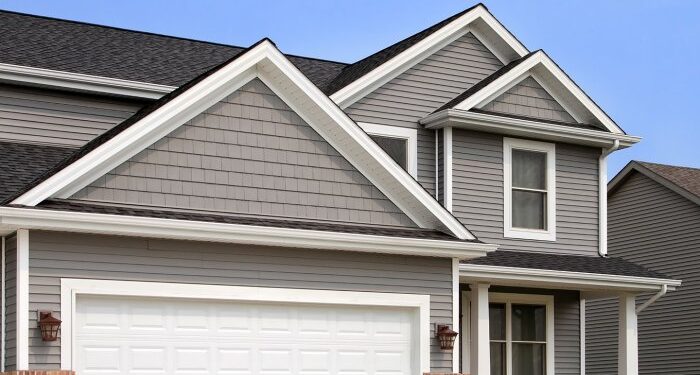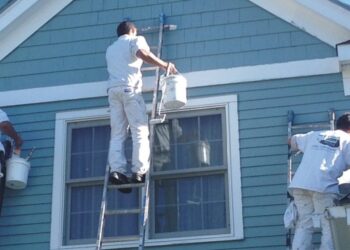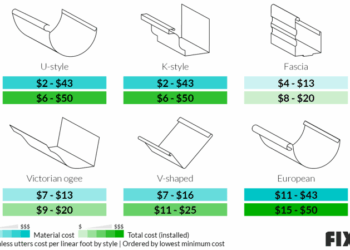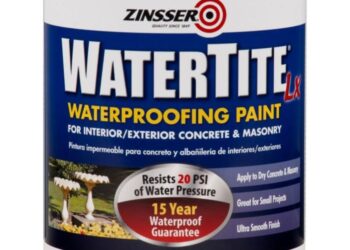Delving into the realm of vinyl siding installation cost, this guide aims to shed light on the various factors influencing expenses, average cost ranges, cost-saving strategies, and the return on investment. Let's embark on this informative journey together.
Providing detailed insights and valuable information on the intricacies of vinyl siding installation cost, this guide is designed to equip readers with essential knowledge for their home improvement endeavors.
Factors Affecting Vinyl Siding Installation Cost
When considering the cost of vinyl siding installation, there are several key factors that can impact the overall expense. Factors such as material quality, siding style, labor costs, additional features, geographical location, and seasonality all play a role in determining the final cost.
Material Quality and Siding Style
The quality of the vinyl siding material used and the chosen style can significantly affect the installation cost. Higher quality materials often come with a higher price tag, but they are also more durable and offer better aesthetic appeal. Similarly, certain siding styles may require more intricate installation techniques, leading to higher labor costs.
Labor Costs and Additional Features
Labor costs are another important factor to consider when calculating vinyl siding installation expenses. The complexity of the installation, the size of the project, and the experience of the contractors can all impact labor costs. Additionally, features like insulation, trim work, and the removal of old siding can add to the overall cost of the installation.
Geographical Location and Seasonality
The geographical location of the property can also influence the pricing of vinyl siding installation. Areas with a higher cost of living or where materials need to be transported long distances may have higher installation costs. Furthermore, seasonality can play a role in pricing, as demand for siding installation may fluctuate throughout the year, affecting labor costs and availability of contractors.
Average Cost Range for Vinyl Siding Installation
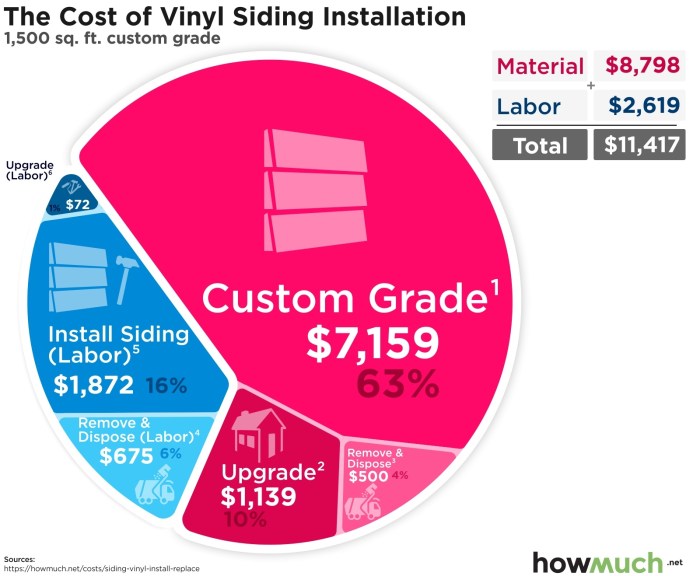
Installing vinyl siding can vary in cost depending on various factors. On average, the cost per square foot for vinyl siding installation ranges from $3 to $7. The total cost is influenced by the quality of the materials used, the size of the project, and the complexity of the installation process.
Cost Breakdown
- Low-End Estimate: The low-end estimate for vinyl siding installation is around $3 per square foot. This estimate typically includes basic materials and straightforward installation on a standard-sized home.
- High-End Estimate: On the other hand, the high-end estimate can reach up to $7 per square foot. This higher cost is often associated with premium materials, intricate designs, or challenging installation requirements.
Project Size and Complexity Impact
- Small vs. Large Homes: The size of the project directly affects the overall cost. Larger homes require more materials and labor, leading to higher costs compared to smaller homes with less square footage.
- Complexity of Installation: Projects that involve complex designs, multiple stories, or unusual architectural features may incur additional costs due to the specialized skills and extra time needed for installation.
DIY vs. Professional Installation
- DIY Installation: Opting for a do-it-yourself approach can lower the overall cost of vinyl siding installation. However, DIY projects may lack the professional finish and expertise that a contractor can provide, potentially leading to maintenance issues in the future.
- Professional Contractor: Hiring a professional contractor ensures proper installation, quality workmanship, and warranty coverage. While this option may be more expensive upfront, it can save money in the long run by preventing costly repairs or replacements.
Cost-saving Tips and Strategies
When it comes to vinyl siding installation costs, there are several strategies homeowners can implement to save money and stay within budget. Proper planning, smart choices, and taking advantage of available discounts can make a significant difference in the overall cost of the project.
Advantages of Bundling Services or Materials
One effective way to reduce vinyl siding installation costs is by bundling services or materials. This involves hiring a contractor who can provide both the siding materials and installation services. By bundling these services together, homeowners can often secure a better deal and save money compared to sourcing them separately.
Additionally, contractors may offer discounts for bundling services, making it a cost-effective option for homeowners.
Potential Discounts, Rebates, or Financing Options
Another way to save on vinyl siding installation costs is by exploring potential discounts, rebates, or financing options. Some manufacturers or contractors may offer discounts for purchasing siding materials in bulk or during off-peak seasons. Homeowners should also inquire about any available rebates for energy-efficient siding options, as these can help offset installation costs.
Additionally, exploring financing options such as low-interest loans or payment plans can make the project more affordable in the long run.
Return on Investment (ROI) for Vinyl Siding Installation
Installing vinyl siding can offer homeowners a significant return on investment (ROI) in various ways. Not only does it enhance the aesthetic appeal of the property, but it also provides long-term cost savings and increased property value.When it comes to energy efficiency, vinyl siding acts as a protective barrier against external elements, helping to regulate indoor temperatures.
This can lead to lower energy bills over time, as the HVAC system doesn't have to work as hard to maintain a comfortable environment.In terms of maintenance savings, vinyl siding is relatively low maintenance compared to other siding materials like wood or brick.
It does not require regular painting or sealing, saving homeowners time and money on upkeep costs.The durability and longevity of vinyl siding also play a crucial role in the ROI. Vinyl siding is resistant to rot, insect damage, and moisture, ensuring that it can last for many years without needing replacement.
This longevity translates to cost savings in the long run, as homeowners don't have to worry about frequent repairs or replacements.When evaluating the ROI of vinyl siding installation, homeowners should consider factors such as the initial cost of installation, potential energy savings, maintenance costs, and the impact on property value.
It's essential to weigh these factors against each other to determine the overall return on investment and make an informed decision about whether vinyl siding is the right choice for their home.
End of Discussion
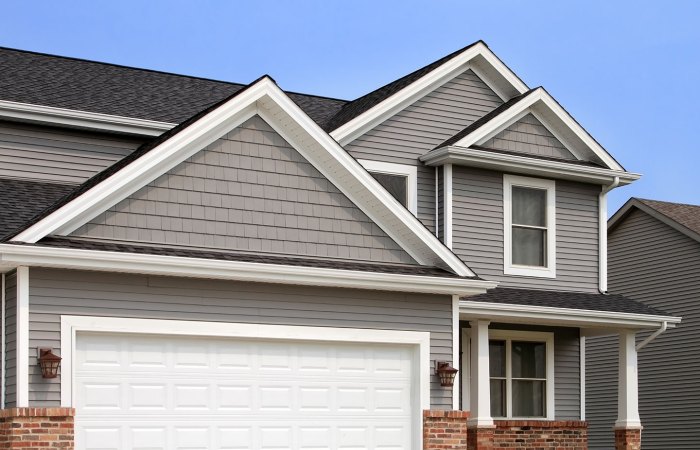
In conclusion, understanding the nuances of vinyl siding installation cost is crucial for homeowners looking to enhance their property. By implementing the tips and strategies Artikeld in this guide, individuals can make informed decisions and maximize the benefits of their investment.
Query Resolution
What factors can affect vinyl siding installation cost?
Factors such as material quality, siding style, labor costs, additional features like insulation, trim work, removal of old siding, geographical location, and seasonality can impact the overall expense.
What is the average cost range for vinyl siding installation?
The average cost range per square foot varies, with low-end and high-end estimates. Costs can also differ based on the size of the project and complexity of installation.
How can homeowners save on vinyl siding installation costs?
Homeowners can reduce costs through proper planning, budgeting, bundling services or materials, and exploring discounts, rebates, or financing options.
What is the return on investment for vinyl siding installation?
Installing vinyl siding can lead to energy efficiency, maintenance savings, and increased property value. The durability and longevity of vinyl siding contribute to long-term cost savings for homeowners.
Delving into the realm of vinyl siding installation cost, this guide aims to shed light on the various factors influencing expenses, average cost ranges, cost-saving strategies, and the return on investment. Let's embark on this informative journey together.
Providing detailed insights and valuable information on the intricacies of vinyl siding installation cost, this guide is designed to equip readers with essential knowledge for their home improvement endeavors.
Factors Affecting Vinyl Siding Installation Cost
When considering the cost of vinyl siding installation, there are several key factors that can impact the overall expense. Factors such as material quality, siding style, labor costs, additional features, geographical location, and seasonality all play a role in determining the final cost.
Material Quality and Siding Style
The quality of the vinyl siding material used and the chosen style can significantly affect the installation cost. Higher quality materials often come with a higher price tag, but they are also more durable and offer better aesthetic appeal. Similarly, certain siding styles may require more intricate installation techniques, leading to higher labor costs.
Labor Costs and Additional Features
Labor costs are another important factor to consider when calculating vinyl siding installation expenses. The complexity of the installation, the size of the project, and the experience of the contractors can all impact labor costs. Additionally, features like insulation, trim work, and the removal of old siding can add to the overall cost of the installation.
Geographical Location and Seasonality
The geographical location of the property can also influence the pricing of vinyl siding installation. Areas with a higher cost of living or where materials need to be transported long distances may have higher installation costs. Furthermore, seasonality can play a role in pricing, as demand for siding installation may fluctuate throughout the year, affecting labor costs and availability of contractors.
Average Cost Range for Vinyl Siding Installation

Installing vinyl siding can vary in cost depending on various factors. On average, the cost per square foot for vinyl siding installation ranges from $3 to $7. The total cost is influenced by the quality of the materials used, the size of the project, and the complexity of the installation process.
Cost Breakdown
- Low-End Estimate: The low-end estimate for vinyl siding installation is around $3 per square foot. This estimate typically includes basic materials and straightforward installation on a standard-sized home.
- High-End Estimate: On the other hand, the high-end estimate can reach up to $7 per square foot. This higher cost is often associated with premium materials, intricate designs, or challenging installation requirements.
Project Size and Complexity Impact
- Small vs. Large Homes: The size of the project directly affects the overall cost. Larger homes require more materials and labor, leading to higher costs compared to smaller homes with less square footage.
- Complexity of Installation: Projects that involve complex designs, multiple stories, or unusual architectural features may incur additional costs due to the specialized skills and extra time needed for installation.
DIY vs. Professional Installation
- DIY Installation: Opting for a do-it-yourself approach can lower the overall cost of vinyl siding installation. However, DIY projects may lack the professional finish and expertise that a contractor can provide, potentially leading to maintenance issues in the future.
- Professional Contractor: Hiring a professional contractor ensures proper installation, quality workmanship, and warranty coverage. While this option may be more expensive upfront, it can save money in the long run by preventing costly repairs or replacements.
Cost-saving Tips and Strategies
When it comes to vinyl siding installation costs, there are several strategies homeowners can implement to save money and stay within budget. Proper planning, smart choices, and taking advantage of available discounts can make a significant difference in the overall cost of the project.
Advantages of Bundling Services or Materials
One effective way to reduce vinyl siding installation costs is by bundling services or materials. This involves hiring a contractor who can provide both the siding materials and installation services. By bundling these services together, homeowners can often secure a better deal and save money compared to sourcing them separately.
Additionally, contractors may offer discounts for bundling services, making it a cost-effective option for homeowners.
Potential Discounts, Rebates, or Financing Options
Another way to save on vinyl siding installation costs is by exploring potential discounts, rebates, or financing options. Some manufacturers or contractors may offer discounts for purchasing siding materials in bulk or during off-peak seasons. Homeowners should also inquire about any available rebates for energy-efficient siding options, as these can help offset installation costs.
Additionally, exploring financing options such as low-interest loans or payment plans can make the project more affordable in the long run.
Return on Investment (ROI) for Vinyl Siding Installation
Installing vinyl siding can offer homeowners a significant return on investment (ROI) in various ways. Not only does it enhance the aesthetic appeal of the property, but it also provides long-term cost savings and increased property value.When it comes to energy efficiency, vinyl siding acts as a protective barrier against external elements, helping to regulate indoor temperatures.
This can lead to lower energy bills over time, as the HVAC system doesn't have to work as hard to maintain a comfortable environment.In terms of maintenance savings, vinyl siding is relatively low maintenance compared to other siding materials like wood or brick.
It does not require regular painting or sealing, saving homeowners time and money on upkeep costs.The durability and longevity of vinyl siding also play a crucial role in the ROI. Vinyl siding is resistant to rot, insect damage, and moisture, ensuring that it can last for many years without needing replacement.
This longevity translates to cost savings in the long run, as homeowners don't have to worry about frequent repairs or replacements.When evaluating the ROI of vinyl siding installation, homeowners should consider factors such as the initial cost of installation, potential energy savings, maintenance costs, and the impact on property value.
It's essential to weigh these factors against each other to determine the overall return on investment and make an informed decision about whether vinyl siding is the right choice for their home.
End of Discussion

In conclusion, understanding the nuances of vinyl siding installation cost is crucial for homeowners looking to enhance their property. By implementing the tips and strategies Artikeld in this guide, individuals can make informed decisions and maximize the benefits of their investment.
Query Resolution
What factors can affect vinyl siding installation cost?
Factors such as material quality, siding style, labor costs, additional features like insulation, trim work, removal of old siding, geographical location, and seasonality can impact the overall expense.
What is the average cost range for vinyl siding installation?
The average cost range per square foot varies, with low-end and high-end estimates. Costs can also differ based on the size of the project and complexity of installation.
How can homeowners save on vinyl siding installation costs?
Homeowners can reduce costs through proper planning, budgeting, bundling services or materials, and exploring discounts, rebates, or financing options.
What is the return on investment for vinyl siding installation?
Installing vinyl siding can lead to energy efficiency, maintenance savings, and increased property value. The durability and longevity of vinyl siding contribute to long-term cost savings for homeowners.

